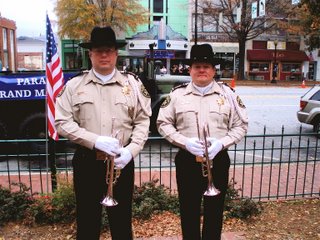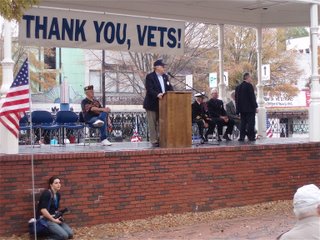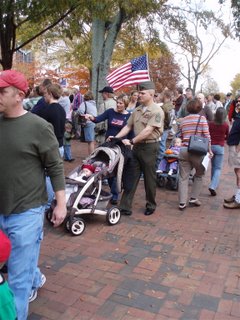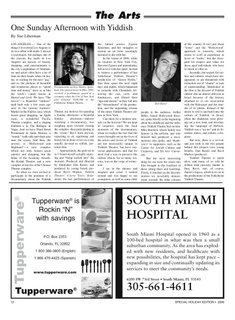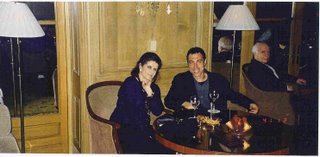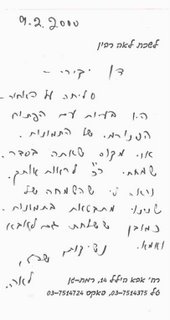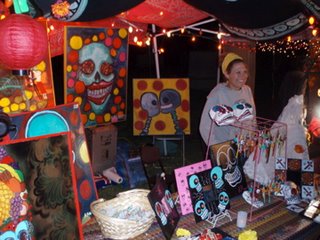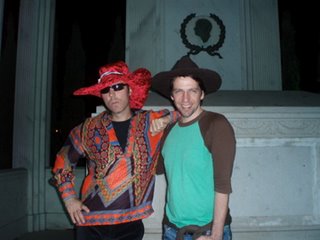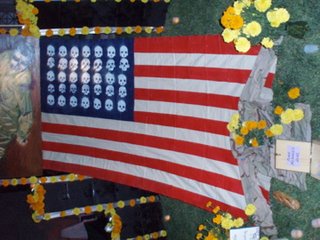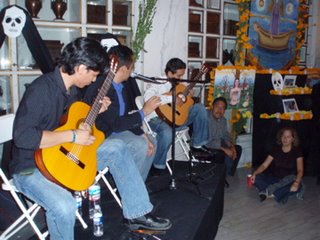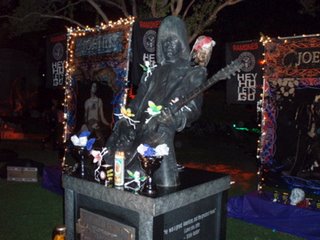I just got this paper, written by a student in the Lamont School of Music at the University of Denver, which also referenced my film. She sent it to me.
As I think I once had mentioned, I'd love to have all the papers written about my film on my blogs, for others to be able to read. I know lots of papers have been written about "Out for love", throughout the years, taking a look at different perspectives of the film. Some have focused on the film. Some, like this one, just referenced it. Doesn't matter. Some people have emailed me, telling me they didn't like their own paper, so they didn't want it published.
Anyways. I promise not to critic the paper. I'll put it on my website regardless if I agree with the political stance it takes.
Thanks Nicolette, for sharing your work with me and my one and a half readers.
XOX
Dan
Nicolette PigeonThe Palestinian-Israeli Conflict and the Role of Music From the time Israel declared statehood in 1948 and launched a war, the Palestinian people—native to the land Zionists wanted—have been marginalized within the State. Because of the second-class treatment of Palestinian-Israelis, the road to peace in Israel is still ongoing. Many wars and uprisings have occurred, taking the lives of thousands of both Israelis and Palestinians. However, the arts have always played a role in shaping and reflecting the attitudes of the people who are a part of the conflict. Music and film are two major mediums through which each side expresses their attitude about the situation. Two categories—education and popular culture—exist where tangible changes can be seen through music and film. In the process, these two art forms help bring Israelis and Palestinians closer to finding a lasting form of peace.
Education in Israel: Divided and Slow to Change
In the sector of education, there are efforts to call attention to the inequalities between Palestinian and Israeli levels of education. To begin with, new groups have been formed to bring these two groups together as young children. Because most Palestinians live in “occupied territory” such as Gaza and the West Bank and because of restrictions of movement, many Israeli and Palestinian children never meet or cross paths with those who are different from them. As a result of that, new organizations have emerged that wish to change this unfortunate reality. In Arthur Waskow’s article “Heal the Heart, Heal the World” from The Jerusalem Report, he details what his group, The Shalom Center, has done to help this rift. For example, the group organized a “Seder [meal] of the Children of Abraham, Hagar & Sarah” to draw attention to the Israeli-Palestinian conflict. By joining the Jewish children of Abraham and Sarah as well as the Islamic children of Abraham and his slave Hagar, the group aims to promote unity. They also use music to draw children together.
The center’s endeavor to promote peace is through two sayings: tikkun olam and tikkun halev. Tikkun olam means “heal the world.” This can be translated as actions that bring the world closer to peace and allow for social justice to take place. On the other hand, tikkun halev means “heal the heart.” The main goal of The Shalom Center is for Palestinians and Israelis to find peace within them so it can translate into their actions, promoting peace throughout the world. It is a high goal, but one that can be accelerated through children. Their young minds are pliable to new viewpoints, and new environments stressing acceptance and healing could change the divided situation in Israel. Personally, change must begin with children. Their young minds have an easier time accepting others and changing their way of thinking because they are “new” to the world. It is my hope that The Shalom Center will continue to offer meals and music for Israeli and Palestinian children. The words expressed during the meals and the unspoken words felt while playing or listening to music have the power to change the way these segregated children think of and see others in their country.
In the area of higher education, some have called for extreme measures against state-controlled universities. There are only a few universities in Israel, which are located in Haifa, Tel Aviv, Beer-Sheva and Jerusalem. All of these universities are situated in places that benefit the mostly Israeli population; they accept an incredibly small number of Palestinians each year. Because very little funding is given to Palestinian schools, these students’ test scores tend to be lower, and as a result, their acceptance at universities is quite limited. Richard Garner sheds light on the higher education issue in the context of the Palestinian-Israeli conflict with his article, “Lecturers; Union Supports Boycott of ‘Apartheid’ Israel,” featured in The Independent. To begin with, he details that one of Britain’s largest unions called for a boycott of Israeli universities to protest the government’s apartheid-like Palestinian policies. He goes on to explain why he uses the term “apartheid:”
“An exclusion wall had been built in Palestine to separate the communities, which led to unequal development for the two…we are asking our members […] should we or should we not work with Israeli institutions or individuals who turn away from what is happening in Palestine…” (Garner).
Thus, apartheid here represents the segregation found in higher education between Palestinians and Israelis, with Israeli universities playing a part in its perpetuation. For example, Israeli music academies have given rise to some of the most celebrated classical musicians in the world. Violinist Itzhak Perlman studied at the Academy of Music in Tel Aviv and went on to have a great worldwide career. Because he is Jewish and Israeli, he had a much better chance of going to a large Israeli university than a prospective Palestinian student. The “products” of Israeli universities reflect the inequality of education offered at the university level.
Later in the article, Garner brings up the point that many believe a boycott would hurt Israelis’ academic freedom. However, the argument is that they must pressure the benefiting side to bring the Palestinians’ problem to the surface. In this way, it is possible that the State will rethink its policies toward education of the two groups. Progress can already be seen in this arena, as a large Association of University Teachers highlighted three universities as being “complicit in the Israeli government’s ‘abuse’ of Palestinians” (Garner), calling for a boycott of these schools. Unfortunately, the majority of university officials strongly lashed out, causing the association to abandon the motion at a conference.
Popular Culture: Hierarchy, Nationalism, and Musical Fusion
Besides the education sector, those in the popular music area stood to gain the most in influencing the public during the height of the Palestinian-Israeli conflict. To begin with, the hierarchy of popular music serves to hinder Palestinian art forms, including music. Ilan Pappé’s article “Post Zionism and Its Popular Cultures” helps define what took place when the agenda of Zionism loosened its hold on popular culture.
Pappé gives a sense of the general direction in which popular culture was heading according to its Zionist approach. In the 90s, artists questioned the State’s control of popular culture. This movement, while most prominent in the 90s, actually began in the 1980s. Artists of every medium began offering works that portrayed a different Israeli self-image. This differed from the State’s early stance on popular culture; the time period of the 50s and 60s showed a strong Zionist slant, geared towards making the new nation unified and whole. Therefore, Israeli nationalism was viewed only through the lens of Zionism. Mizrachim from this generation were often left out of the main loop, and riots began in the 70s to protest this one-track viewpoint. In fact, the Mizrachim invented an organization called “The Black Panthers,” borrowed from African Americans, to show that they were a group to be noticed, not marginalized.
Education also directly influences popular culture, as the way education is handled affects how popular culture portrays the students receiving education. Pappé explains that before the 1967 war with Lebanon, Palestinians were labeled “refugees” through popular culture. Israeli citizenship was just a euphemism for their real station, which was much lower. As a result of Israelis digesting this viewpoint, the Palestinians were left out of popular culture. They had to insulate their own music and film to ensure that it still survived in the ignorant environment. After the Six Day War in 1967, the viewpoint changed again. Palestinians in the public sphere were largely regarded as terrorists. From this conclusion, many came to see the Palestinians as conspirators against the State of Israel; many thought they were trying to destroy the Jewish state. In reality, their objective was to get recognition as true Israeli citizens.
The real changes in education did not come until the 70s, when Haifa University sociologists challenged the Zionist way of looking at others. The early Zionist ideals were challenged; the “few against the many” idea was regarded as obscuring the facts of the “War of Independence.” While many modern readers would see this change as a breath of fresh air, many Israelis balked at their findings. Israel still wanted to believe that their war in 1948 was a holy war (tohar ha-neshek or “purity of arms”). They did not want to believe that it was a terrible event that left many Palestinians without a home or identity. Fortunately, some did believe these viewpoints; post-Zionist thinkers now expose academia’s role in the decline of freedom of thought and critique in Israel. Recognizing that universities and other educational centers perpetuated anti-Palestinian thinking helps those in the arts portray the other side of the story.
Pappé then turns to film endeavors that try to change Zionist thinking. Films before the present day often show racism and Zionist stereotypes. Mizrachim and Palestinians were often regarded as stupid and inferior, and film characters reflect this problem. For example, the 1964 film “Salah Shabati” exemplifies the Mizrachi stereotype; Shabati is rough, dirty, and “drunkenly” slurs his Hebrew. However, films in the 60s and 70s changed. Here, more personal accounts depicted the private lives of Palestinians who had long been discriminated against. They sought to change their stereotypical roles and showed critical views of Israel’s past and future. By the 80s, filmmakers now used romance to show different kinds of viewpoints. In particular, the “Romeo and Juliet” plot was often used. Here, they would switch the roles of villain and hero so that the Palestinian was now the hero and the Israeli the villain. This helped create sympathy toward the Palestinians’ place in history, not just the Israelis.’ In addition, second generation Mizrachi Jews produced films showing the intense frustration felt by the Arab Jews toward the Ashkenazi Jews. The irate tone of the films suggests that they wish to grab the viewer by the lapels and make them pay attention to their own perspective. For Pappé, this was essential to change the dominant viewpoint: “Yet for the Israeli Jewish public, films about “discovery” of past Israeli “sins” had the greatest impact” (Pappé 89). This general film history overview shows the trends that influence more current films about the Israeli-Palestinian conflict.
Other authors shed light on music’s role in promoting Israeli-Palestinian peace. Inbal Perelson’s article “Power relations in the Israeli Popular Music System” examines the hierarchy which dominates popular music and its relation to Palestinians. He begins the article saying the attempts to establish peace agreements have had a positive impact. Groups of musicians began combining languages when peace agreements were under way. Hebrew and Arabic became mixed in lyrics, reflecting an idea to bring the two conflicting sides together. In addition, the period from 1988 onward has seen Israeli Hebrew songs sung by Arabic singers. By doing this, Perelson states that it “…broadens (or could broaden) the defined boundaries of a specific genre within Israeli popular music, called Zemer Ivri” (Pereson 113). Challenging the norms of Hebrew popular songs brings Palestinian musicians and their performances to the forefront.
In addition, songs with beautiful melodies that embody Zionist ideals in the lyrics have been staples at State ceremonies for a long time. Because Palestinians (referred to as “Arab singers,” pg. 113) have stretched the boundaries of this kind of song, they make it easier for future Palestinians to survive in the popular culture environment. This group, then, is seemingly out of place, but it is necessary for exposure. Thus, even with Israelis as the most powerful influence in Hebrew song, Palestinian singers can still exist within the traditional Israeli parameters.
Also, Perelson points out that the conflict between Israeli-Western harmony and a Palestinian-“Oriental” harmony has created conflict within the music world. The view of “oriental” harmony has created the idea that Palestinian music wasn’t nationalistic, it was just folk music. The Israelis discriminated against them based on the fact that their melodies sounded like “ethnic” or “folk” melodies; Western harmony (i.e., Mozart, Beethoven, etc.) was seen as superior. Fortunately, that viewpoint changed in the 40s. Today, groups fuse the two harmonies to create different sounds. Perelson is quick to point out, though, that Israelis have “appropriated” the harmonies to benefit their songs. While some groups seek to promote tolerance of Arabs through this fusion, many do as Perelson concludes, making this kind of harmony suitable for national Israeli songs but not legitimate as their own category of Israeli music.
One group in particular has dedicated itself to the fusion of Eastern and Western music, seen in the article “Abraham’s Children” by Yossi Klein Halevi from The Jerusalem Report. Founded in 1991 by Avshalom Farjun, the group Bustan Avraham (Garden of Abraham) has brought together both Israeli and Palestinian musicians to create new works. The seven-piece band includes Farjun (qanoun), Miguel Herstein (banjo), Zohar Fresco (percussion), Taiseer Elias (oud), Nassi Dakwar (violin), Amir Milstein (flute), and Emmanuel Mann (bass). The two Palestinian Israelis of the group, Elias and Dakwar, willingly create music with their mostly Israeli counterparts to create a new kind of popular music. Bustan is difficult to categorize within the popular music structure because they do not belong in Israeli or Arab popular music exclusively. Their goal is “the creation of an Israeli culture in which both Jews and Arabs can find reflections of themselves” (Klein Halevi 2). Thus, bits from each of their respective traditions remain in their songs, drawing the two sides together.
Bustan has not been the only group to fuse the two harmonies; before them came Habreirah Hativit. Two current Bustan members—Herstein and Mann—were a part of this band. Their ideas influenced Bustan, which now vies for real cultural acceptance. I think mixing two harmonies that are seemingly opposed shows me how influential music can be. In other periods of history, mixing “national” music was nearly considered treason. Consider the effect Wager had with his “Gesamtkunstwerk” (Total Work of Art), the national ideal. His isolation of the German community and promotion of “superior” German music was so influential that Hitler later revered him as one of Germany’s greatest composers and thinkers. It is no surprise to me, then, that efforts to integrate music, not isolate it, can have the opposite effect. There is room for peace between Israelis and Palestinians with the integration of music as a tiny seed.
Film: Reflections of Past Heartache and Hope for the Future
I found a film that explores bringing people of different backgrounds together through music. Entitled Playing for Peace, it was made in 1993 by director Peter Rosen, documenting the New Hampshire Apple Hill Chamber Players’ tour of the Middle East, where they play concerts and give master classes at conservatories. The group stops in four countries: Israel, Egypt, Jordan, and Syria. They give scholarships to eleven young students in these countries, inviting them to come to New Hampshire and play for a summer with others from different countries and backgrounds.
The opening scene of each country’s segment shows footage of street life in the area. For example, the opening scene in Syria shows the decorated buildings and bustling street life. This technique sets up the universities and conservatories. Depending upon the country, the facility is new, well-kept, or shabby. For instance, the Conservatory of Music in Tel Aviv is a very well-kept facility; here, the study of classical music is encouraged. Israel’s secular population brought the European conservatory tradition here to the Middle East. As a result, the children studying here are quite skilled. The group picks five students and their scholarships are presented at the classical piano trio/quartet concert at the U.S. Ambassador’s home. One student here stands out. Yishay Ratz, a violinist from Carmiel, is troubled about getting leave from the army. Israel’s focus on strengthening the army shows here; Yishay serves as a security agent of some sort. However, he is granted permission from the army to come to the Apple Hill camp.
In Egypt, Cairo is the center for music. At its conservatory, the majorities of students play both Eastern and Western music quite well. Apple Hill finds two students: Ihab Zaki (30 years old) and Mina Mikhail (15 years old). They represent the extremes of the age spectrum at the camp. The main point in Cairo is that the university encourages the mixing of Eastern and Western music. The cellist, Ihab, played both well-known classical pieces as well as modal-sounding native music. This parallel to Bustan creates tolerance of other kinds of music, which can aid peace efforts.
When we arrive in Jordan, it is clear that poverty is more visible and that music is not encouraged the same way as in Cairo and Tel Aviv. Their National Music Conservatory is very new and mostly features beginning violin students. One violinist, Mona Minwer of Iman, is chosen. Here, the emphasis of the film is upon mixing the traditional and secular Arab lifestyles. The University of Jordan campus shows both traditional dress and very popular Western styles. In a small way, Jordan mixes the East and West, and the result is that many students of all ethnicities study here. Among the Palestinian and Iraqi students, we also find European and Japanese students. Thus, while this conservatory was rudimentary in music skill, their approach in combining students of all ethnicities and nationalities is advanced.
Syria, the last country on Apple Hill’s tour, features the world’s oldest city, Damascus. Its arts complex is a towering piece of architecture. Here, classical music has been passed on by Russian teachers who grew learned traditional conservatory training. The group finds some of their best students here because of the intensity of training and the students’ desire to learn. Kinan Athmeh, a clarinetist, and Dania Taba’a, a pianist, are given scholarships to attend Apple Hill. What is most interesting about Syria is its strange mix of music. While staying in Syria and playing concerts, the group finds a Dixieland band that has learned some of the hits. Here, Turkish architecture exists with Russian pedagogy, Dixieland, and Middle Eastern students.
Once the students arrive at Apple Hill, they encounter changes in scenery and attitude. Yishay comments on how green New Hampshire is, while Dania states that she “feels free” here in America. The students feel that way when they begin playing together. The staff at Apple Hill combines the eleven students with four Americans to make quartets (two violins, viola, and cello), quintets, piano trios (piano, cello, violin) and wind quintets. Many members expressed concerns about getting along with their fellow instrumentalists. For instance, Israeli twins Shuli and Tomi Waterman worry about interacting with their Syrian pianist, Dania. After the first rehearsal, though, they are impressed; here, music creates a counter-language to communicate with.
The members of the Apple Hill Chamber Players aim for this kind of interaction. Crossing forbidden boundaries is easier when the language—music—is common to everyone. No matter what level each student had when playing, the goal was the same: to communicate with the others in the group through music. Apple Hill hopes that these students will take their experiences and apply this selfless kind of thinking to their interactions in the Middle East. However, their environment may not allow it. I found the film moving, but the “kumbayah” approach is not very realistic. However, stressing music as a universal language is the key to approaching different people. Finding common ground could be the first step, though small, towards the goal of harmony in the conflict-torn Middle East.
In addition, the film “Yatzati L’Hapes Ahavah—Techef Ashuv” by Dan Katzir (Out for Love—Be Back Shortly; 1997) is an autobiographical film diary mixed with the public events surrounding Yitzhak Rabin’s assassination in 1995. Through Dan’s story, we see how difficult it can be to find and sustain a personal relationship in the midst of conflict. In the film, Dan meets his girlfriend Iris Arie in Tel Aviv near Dizengoff Square. When he is out with her, everything is perfect, and his musical choices reflect that; he plays French songs such as “La Vie en Rose.” However, the scenes where citizens of Tel Aviv burn flags and chant “Down with Rabin” are conspicuously quiet. Beyond the shouts of the crowd, there is no sound. Music, then, does not serve the radical groups; they wish to use subjective words to unify against others who do not share their ideas. In contrast, Rabin’s assassination shows a remarkable change in the role of music. The public begins singing a song about Rabin that spread throughout memorials around the country, and the lyrics translated were this one line: “Let the sun rise and sing for peace.” Music becomes an important unifying factor for Israel. Iris sings at the makeshift memorials springing up, and Dan finds it hard to get involved in the singing even when others connect. Thus, even with lyrics, Israel can collectively grieve this way.
Joseph Massad’s article in Palestine, Israel, and the Politics of Popular Culture entitled “Liberating Songs: Palestine Put to Music” details how music can mobilize a minority group to act. One section of the article, “Arab Dream,” shows how one song can transform a community, much the way one song became the public grieving song for slain Prime Minister Rabin. For example, when Arafat signed the Oslo Accords in 1993, the Palestinian community was very upset. The following Jordanian-Israeli treaty created more chaos, and the Palestinian national vision was in ruins. However, a new televised song changed the attitude of the entire Palestinian community. The song was entitled “Al-Hulm al-‘Arabi” (The Arab Dream) and showcased many different Arab vocalists. Emotional footage that accompanied the song created collective identification, and had this effect:
“These songs have obviously not brought about the liberation of Palestine […] Nonetheless, the songs both express and register the changing dynamics of the Palestinian struggle, reflecting which segment of the Palestinian people is most prominent at the moment and which form of struggle is imagined as most effective” (Massad 197).
The effect is that the people have a voice. This is important in the Israeli-Palestinian conflict because seeing the other person’s viewpoint is important. Music can play an important role in expressing the emotions of conflicting peoples and help bring those involved closer to hearing the other view. While is seems like a long shot, I believe it is a possible avenue toward peace.
Music can play an important role in bringing about peace in the Middle East. Whether it is through education or through music, the main theme is collaboration. Coming together through music can create a common language. While problems in the Middle East are often too complicated for such a simplistic solution, applying music more effectively with peace treaties can show surprising results. Songs and mixed musical groups can be used to unify whole groups of people and draw people of different backgrounds together. It is my hope that the Israeli-Palestinian conflict can at least be lessened through music. Ideally, it would serve as the catalyst for changing dividing attitudes in Israel.
Works Cited/Consulted
Garner, Richard. "Lecturers' Union Supports Boycott of 'Apartheid' Israel."
The Independent 30 May 2006.
Halevi, Yossi Klein. "Abraham's Children." The Jerusalem Report (June 1995): 42.
Hofman, John E., et al. Arab-Jewish Relations in Israel: A Quest in Human
Understanding. Bristol, Indiana: Wyndham Hall Press, 1988.
Pappé, Ilan. "Post-Zionist Critique on Israel and the Palestinians Part III:
Popular Culture." Journal of Palestine Studies 26.4 (Summer 1997): 60-69.
Perelson, Inbal. "Power Relations in the Israeli Popular Music System."
Popular Music 17.1 (Jan. 1998): 113-128.
Playing for Peace. Dir. Peter Rosen. 1993. Videocassette. Peter Rosen
Productions, Inc., 1993.
Stein, Rebecca L. and Ted Swedenburg, editors. Palestine, Israel and the
Politics of Popular Culture. Durham, N.C.: Duke University Press, 2005.
Waskow, Arthur. "Heal the Heart, Heal the World." The Jerusalem Report (June
2005): 47.
Yatzati L'Hapes Ahavah--Techef Ashuv (Out for Love--Be Back Shortly). Dir. Dan
Katzir. 1993. DVD. New Love Films, 1993.

